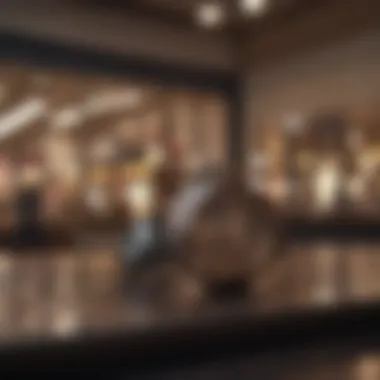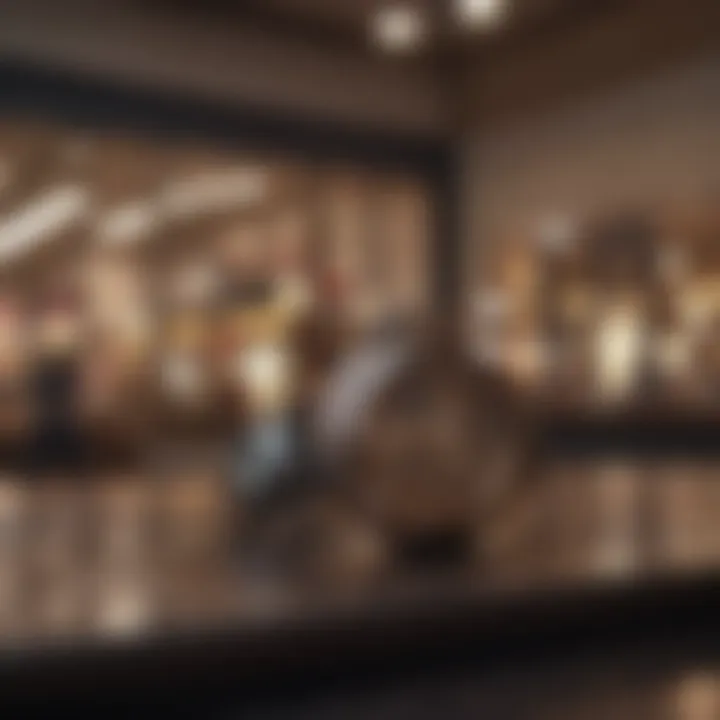Luxury Outlet Stores: Trends and Insights


Intro
The retail landscape has witnessed a significant metamorphosis over the past few decades, and among the most intriguing innovations are outlet stores specifically designed for luxury brands. These outlets have transitioned from mere clearance locations to essential components of luxury retail strategy. As luxury brands navigate a competitive market, it becomes crucial to analyze how these outlets have evolved and the profound impact they have on consumer behavior and brand perception.
Outlet stores originally emerged as a way for luxury brands to manage excess inventory without diluting the brand image. Today, they serve as a channel to attract a broader consumer base while preserving exclusivity. This duality presents a fascinating exploration into how brand strategies are crafted to engage consumers who seek quality but at more accessible price points.
This article aims to unravel the complexities associated with luxury brand outlets. By examining their evolution, market dynamics, and the psychology at play in consumer shopping behavior, we can gain greater understanding of this unique retail sector. Additionally, the article assesses the strategic positioning of these outlets within the retail landscape and their implications for brand equity.
Through a detailed investigation of pricing strategies, target demographics, and ongoing digital transformations, we aim to point out prevailing trends and future directions for luxury outlets. This exploration intends to shed light on what influences consumer preferences and purchasing decisions in an ever-evolving marketplace.
Understanding Luxury Brand Outlets
Understanding luxury brand outlets is a crucial aspect of discerning contemporary retail dynamics. Luxury outlets serve as a bridge between exclusive brand identities and consumers seeking premium goods at reduced prices. They play a significant role in the luxury market by addressing both consumer desires and brand strategies. Recognizing the importance of this aspect is key to comprehending the larger narrative of luxury retail.
Benefits of Luxury Brand Outlets
Luxury brand outlets provide several advantages, including:
- Accessibility: They make high-end products accessible to a broader audience, appealing to consumers who may not typically afford full-priced luxury goods.
- Brand Awareness: By hosting higher foot traffic, outlets enhance brand visibility and encourage brand loyalty through exposure.
- Inventory Management: Outlets help brands manage excess inventory, allowing them to clear out stock without tarnishing the prestige associated with their primary retail locations.
However, the significance of luxury outlets is multi-layered. They often operate within a different pricing structure and marketing narrative than flagship stores, attracting discerning shoppers with a keen understanding of brand value. This topic thus merits close examination to appreciate the complex interplay between luxury branding and consumer engagement.
Defining Luxury Brands
Luxury brands are often characterized by their exclusivity, exceptional quality, and significant heritage. Brands like Chanel and Gucci emphasize craftsmanship and design, appealing to consumers' aspirations and self-image through their products. The luxury sector is defined not only by the products themselves but also by the lifestyle they encapsulate. This segment targets affluent consumers who associate ownership with status and identity.
Understanding luxury brands involves not just recognizing their products but also comprehending the experiences they offer. They create narratives around their items that enhance perceived value, creating emotional connections with consumers. The essence of luxury brands lies in their ability to convey sophistication and elegance while maintaining a selective consumer base.
What Classifies an Outlet Store?
An outlet store generally refers to a retail format that sells products at discounted prices. These goods typically include past season items, overstock, or discontinued lines. In the context of luxury, outlet stores must adhere to certain classifications. They maintain a distinct identity that separates them from standard retail operations. Key classifications include:
- Location: Outlets are often located in dedicated outlet centers, which offer multiple brands in one location, fostering a bargain-hunting environment.
- Pricing: Outlets provide significant discounts compared to traditional retail. Prices can be reduced by 20% to 70%, depending on the product and its availability.
- Product Range: Often, luxury outlet stores offer fewer exclusive items. However, they might still feature signature product lines at lower price points.
Historical Context of Outlet Stores
Understanding the historical context of outlet stores is essential for several reasons. First, it provides insights into how these retail spaces originated and evolved. This background allows brands and consumers alike to appreciate the journey of luxury outlets, including their transformation from mere discount centers to strategic retail destinations. Second, examining history reveals the societal and economic factors that have influenced outlet shopping patterns over time. Lastly, this context helps to comprehend current market dynamics and future trends, ensuring that stakeholders can make informed decisions.
Origins of Outlet Shopping
The concept of outlet shopping can be traced back to the mid-20th century, primarily in the United States. Originally, outlet stores emerged as a solution for manufacturers to sell surplus inventory. This inventory often consisted of last season’s designs or excess stock that could not be sold through regular retail channels. For instance, in the 1930s, brands like the Levi Strauss Company began using outlet stores to clear unsold items. Originating in rural areas, these stores were often located near factories, providing customers easier access to discounted goods.
Over time, the model expanded as retailers recognized the potential for a dedicated outlet shopping experience. Brands such as Ralph Lauren and Coach began establishing their own outlet locations during the 1980s. These were no longer just surplus stores, but a significant part of brand strategy. They catered to a growing audience seeking luxury products at more accessible prices.
Evolution Over the Decades
As outlet shopping gained popularity, the landscape underwent significant changes. The 1990s marked a pivotal time with the emergence of premium outlet centers. These centers brought together multiple brands under one roof, creating a shopping experience that appealed to both luxury consumers and bargain hunters. Notable developments included the opening of the Premium Outlet brand, which facilitated the expansion of outlet shopping across the United States and beyond.
In response to changing consumer preferences and the rise of e-commerce, outlet stores have continually adapted. The 2000s saw a significant influence of online shopping on brick-and-mortar outlets. Retailers began integrating digital strategies, allowing customers to browse and purchase items online, while also promoting store exclusives.
"Understanding the historical roots of outlet shopping reveals its transformation from a place of clearance to a strategic component in luxury brand positioning."
The current consumer landscape demands a blend of physical and digital experiences. This shift has led to innovations such as click-and-collect services, combining convenience with the allure of in-store shopping. Future advancements in technology and sustainability will likely further influence the direction of outlet retailing, continuing the evolution that began decades ago.


Current Market Landscape
The current market landscape for luxury brand outlets is shaped by a variety of factors that reflect both consumer behavior and retail trends. Understanding this environment allows brands to consistently adapt their strategies and ensure they resonate with shoppers. Premium outlet centers and the rise of e-commerce are two critical aspects influencing the success and visibility of luxury outlets today.
Emergence of Premium Outlet Centers
The emergence of premium outlet centers marks a significant shift in how luxury goods are marketed and sold. These centers are not mere discount zones; they have evolved into lifestyle destinations that attract various types of consumers. Premium outlets feature high-end brands at reduced prices, offering both exclusivity and value.
These centers often occupy large spaces and include a selection of luxury retailers, making them appealing to fashion enthusiasts who desire a unique shopping experience. The design and atmosphere of premium outlet centers are aimed at enhancing consumer engagement, featuring open-air layouts, quality dining options, and entertainment venues.
Key points include:
- Strategic Location: Many premium outlet centers are located near urban areas, enhancing accessibility and drawing in both local shoppers and tourists.
- Brand Partnerships: Luxury brands often collaborate to establish a consistent and appealing shopping experience across these outlets.
- Quality Assurance: Despite lower prices, premium outlets maintain quality control of the products offered, preserving brand integrity.
With this emergence, a wider demographic is being attracted to luxury brands, demonstrating that value and luxury can coexist.
Impact of E-commerce on Outlets
The relationship between e-commerce and luxury outlets has transformed the retail landscape in profound ways. Online shopping has fundamentally altered consumer expectations and behaviors, pushing traditional retailers to innovate continually. Despite the convenience of e-commerce, many consumers still appreciate the tactile experience of shopping at physical outlets.
Now, luxury outlets are increasingly integrating online elements into their business models. Here are several key impacts of e-commerce on outlet shopping:
- Omni-channel Strategies: Brands are employing systems that connect online and offline experiences. Customers can browse online, find items available at their nearest outlet, or shop directly from their devices.
- Discounting Dynamics: While online shopping often implies discounts, the e-commerce presence of luxury brands has prompted outlet stores to rethink their pricing strategies. Balancing in-store prices with online offerings requires careful consideration from retailers.
- Consumer Convenience: The allure of shopping online often competes with physical stores. However, luxury outlets can leverage this by enhancing their unique offers to draw customers in.
As the retail environment evolves, luxury outlets must adapt to compete with online platforms while maintaining their distinctive value proposition.
Consumer Psychology and Behavior
Understanding consumer psychology and behavior is vital when discussing luxury brand outlets. This aspect deeply impacts how these stores function in the retail landscape. Shoppers’ motivations, perceptions, and emotional responses all play critical roles in their outlet shopping experiences. Brands must consider these factors to create effective strategies that align with consumer desires.
Motivations for Shopping at Outlets
Several factors drive consumers to luxury outlets. Common motivations include:
- Value for Money: Many consumers perceive that they are getting high-quality products at reduced prices. This perception is particularly potent in luxury retail, where the allure of high-end brands is often accompanied by hefty price tags.
- Bargain Hunting: The thrill of finding a desirable item at a lower price often attracts savvy shoppers. This excitement confirms a sense of accomplishment and can enhance the shopping experience.
- Brand Affinity: Customers often have strong connections to certain brands. Shopping at outlets allows consumers to engage with brands they admire while enjoying financial savings.
- Limited Editions: Outlets might offer items that are exclusive or hard to find elsewhere. This scarcity can heighten customer interest and can drive quick purchasing decisions.
- Social Interaction: Outlet shopping is often a group activity. Friends or families may visit together, creating communal experiences that enhance enjoyment and satisfaction.
In essence, motivations for shopping at luxury outlets intertwine personal interests and social dynamics.
Perception of Value and Discounting
The concept of value in the context of luxury outlets hinges on several important factors. Here are key points that illustrate this:
- Discounts as a Powerful Tool: The psychological impact of markdowns significantly affects purchasing decisions. Consumers often feel they are making a wiser financial choice when they see a discounted price on luxury items.
- Status and Prestige: Owning luxury goods from reputable brands can enhance an individual’s social standing. This aspect means that even at a reduced price, these items retain their high-status character.
- Quality Assurance: Many consumers associate luxury brands with superior quality. When shoppers can buy these high-quality products at lower prices, their perception of value increases dramatically.
- Exclusivity in Discounts: Some outlets provide exclusive specials, which can be appealing to consumers. These unique offers can create urgency and instigate quick purchasing decisions.
"The perception of luxury goods as a reflection of personal identity and status makes shopping at outlets a complex interplay of psychological factors."
Overall, understanding consumer psychology and behavior in luxury outlet shopping offers crucial insights into how to elevate the shopping experience. By appreciating motivations and perceptions of value, brands can effectively cater to their affluent clientele's desires.
Brand Strategy and Positioning
Brand strategy and positioning are fundamental for luxury outlets. They shape how a brand interacts with its audience and how it maintains its prestige while offering discounted products. Luxury brands must walk a fine line between exclusivity and accessibility.
Maintaining Brand Image


Maintaining brand image is crucial for luxury brands operating outlet stores. A successful brand image conveys exclusivity and high quality. When positioned correctly, these outlets can enhance the brand’s visibility without tarnishing its image.
Considerations include:
- Quality Control: Ensuring that products sold in outlets meet the brand's high standards is vital. This prevents negative perceptions.
- Store Design: Outlet stores should reflect the brand's aesthetic. The layout, color palette, and decor must align with the brand's identity.
- Customer Experience: Training staff to uphold brand values in customer interactions creates a consistent experience that resonates with luxury shoppers.
By maintaining a strong brand image, luxury outlets can create a shopping experience that feels authentic and desirable, even in a discount setting.
Selective Distribution Channels
Selective distribution channels further cement a luxury brand's strategy. Choosing where to sell products, including in outlet locations, impacts brand perception. These decisions are strategic and deliberate.
Key aspects of this approach include:
- Brand-Controlled Outlets: Many luxury brands operate their own outlet stores. This allows for direct control over branding and customer experience.
- Partnered Outlets: Collaborating with specific retailers helps maintain a level of selectivity. Only partnering with high-end multibrand outlets protects brand prestige.
- Geographic Considerations: Selecting outlet locations in affluent or strategic areas can attract the right clientele while enhancing the brand’s luxury perception.
In essence, the strategic positioning and differentiated distribution of luxury brands in outlet environments serve to fortify their market presence and uphold their valued image.
"Luxury is not just about the product; it is about the experience and the perception created around it."
This understanding is essential in navigating the unique landscape of luxury retail.
Demographic Insights
Understanding demographic insights is crucial when analyzing the luxury outlet landscape. This section aims to shed light on the specific characteristics of the consumers who engage with luxury brands at outlet stores. By examining demographics, retailers can tailor their strategies to better meet the needs and preferences of their target audience. This can enhance customer experience and ultimately drive sales.
Target Audience for Luxury Outlets
The target audience for luxury outlets generally consists of affluent consumers who seek high-quality products at reduced prices. These individuals are often well-educated and possess disposable income, allowing them to indulge in luxury items without the full financial burden of retail pricing. Common traits among shoppers include:
- Income: Higher household income brackets are predominant in outlet shopping, correlating with the luxury market presence.
- Education: Many luxury shoppers hold advanced degrees, influencing their buying habits and brand awareness.
- Lifestyle: This audience often values exclusivity and prestige, seeking out unique items that align with their identity.
Understanding this demographic allows brands to market themselves more effectively, ensuring that promotions resonate with potential shoppers. Many brands utilize targeted advertising to draw in these consumers, emphasizing exclusivity while promoting affordability through outlets.
Influence of Age and Gender on Shopping Preferences
Age and gender are pivotal factors that shape shopping preferences in luxury outlets. Different age groups exhibit varied shopping patterns, influenced by their life stages and experiences.
- Age Group Trends:
Younger consumers, often millennials and Generation Z, are likely to prioritize both brand image and sustainability. They may engage with online platforms before visiting physical outlets, seeking information and reviews. In contrast, older shoppers might appreciate the tactile experience of shopping in person, focusing on traditional luxury brands. - Gender Dynamics:
Gender can also play a significant role in shopping behavior. Research suggests that women often dominate the luxury market, being more inclined toward fashion and accessories. Men, on the other hand, may lean toward luxury technology and vehicles. Understanding these nuances helps brands tailor their product offerings, marketing strategies, and store layouts.
"Demographics provide actionable insights into consumer behavior, allowing luxury brands to craft engaging shopping experiences."
Digital Transformation in Outlet Retailing
Digital transformation represents a vital shift in the retail landscape, particularly in the realm of luxury outlets. As consumer expectations evolve, outlets must adapt to remain competitive. The incorporation of digital technologies can enhance both the customer experience and operational efficiency. Notably, it streamlines supply chains, personalizes marketing efforts, and improves overall customer engagement. These advancements not only attract new consumers but also retain the existing base.
Online Presence and Integration
Building an online presence is essential for luxury brand outlets. Traditionally, these stores relied heavily on foot traffic and regional clientele. However, an expanding digital footprint enables outlets to engage with a global audience. This includes optimizing websites for search engines, maintaining an active e-commerce platform, and ensuring that the user experience is seamless.
Moreover, integrating online and offline experiences creates a cohesive shopping journey. For instance, the option to purchase online and pick up in-store allows consumers to enjoy the advantages of both realms. Such strategies enhance convenience. Additionally, data analytics can inform inventory management and marketing strategies. This harmonization leads to improved customer satisfaction and brand loyalty.


Role of Social Media Marketing
Social media serves as a powerful tool in promoting luxury brand outlets. Engaging platforms such as Instagram and Facebook enable brands to showcase their products while building community around their offerings. This is particularly valuable for luxury brands, as exclusivity is a significant part of their appeal.
The strategic use of social media can amplify brand awareness, as well as drive traffic to outlet locations and websites. By sharing high-quality content that reflects brand aesthetics, outlets can attract fashion enthusiasts and beauty aficionados.
Furthermore, interactive campaigns on social media can lead to increased consumer interactions. This engagement often translates to stronger emotional connections with the brand. Real-time feedback via these platforms also provides businesses with valuable insights into consumer preferences, allowing for adjustments in strategy as necessary.
"The use of social media is not just an option for luxury brands anymore; it is a critical component of their branding and marketing strategy."
Sustainability and Ethical Considerations
Sustainability and ethical considerations have become cornerstones in the luxury brand landscape. The demand for responsible consumption has grown among consumers, prompting luxury brands to reassess how they operate. This shift is not merely a trend but a reflection of an evolving market where sustainability is imperative. It is vital for luxury brands to align their operations with consumer expectations and global standards.
The benefits of adopting sustainable practices are manifold. Firstly, they enhance brand reputation. Consumers are increasingly favoring brands that exhibit corporate social responsibility. Secondly, ethical sourcing and manufacturing can lead to long-term cost savings. By optimizing supply chains, brands can minimize waste and use resources more efficiently.
Moreover, sustainable practices foster innovation. Brands are exploring new materials and production methods that reduce environmental impact. This not only attracts ethically minded shoppers but also encourages creativity in design and business models. Brands that lead the way in sustainability can set industry standards and potentially influence competitors to follow suit.
"The future of luxury lies in sustainability, where consumers demand more than just quality—they demand responsibility."
Eco-Friendly Practices in Retail
Eco-friendly practices in retail extend beyond mere recycling. Luxurious brands are adopting practices that make a significant impact on the environment. For instance, the use of biodegradable packaging is becoming commonplace. Reducing plastic usage is a critical step many brands are taking.
Additionally, brands are shifting towards sustainable materials. Organic cotton, recycled polyester, and innovative fabrics derived from renewable resources are on the rise. Implementing these materials not only reduces the environmental footprint but also appeals to consumers who are conscious of their purchasing decisions.
Brands are also focusing on energy efficiency in their store operations. Utilizing LED lighting and energy-efficient appliances minimizes energy consumption. This not only contributes to sustainability but also reduces operational costs over time.
Consumer Awareness of Sustainable Brands
As consumers become more aware of the environmental impact of their shopping behavior, the demand for sustainable brands is increasing. Today's shoppers are informed and often skeptical of traditional business practices. They seek transparency regarding how products are made and the source of materials used.
Many luxury brands have begun to create dedicated sections on their websites, detailing their commitment to sustainability. This moves beyond advertising; it embodies a pledge to uphold ethical standards. By engaging consumers with their sustainability stories, brands not only build loyalty but also educate their audience about responsible consumption.
Social media plays a crucial role in fostering this awareness. Platforms like Instagram and Facebook allow brands to showcase their eco-friendly initiatives in a visually engaging way. Through storytelling, brands can connect with consumers on a personal level, highlighting how their products contribute to a more sustainable future.
Future Trends in Luxury Outlet Shopping
The landscape of luxury outlet shopping is undergoing rapid transformations. Understanding these future trends is crucial for both consumers and brands alike. As luxury outlets adapt, they reflect broader shifts in shopping habits, preferences, and technological advancements. It is essential to consider how these trends influence consumer engagement and brand loyalty.
Adaptation to Changing Consumer Preferences
Consumers today are more informed, and their preferences continuously evolve. Luxury brands must recognize these changes to remain relevant. Several factors influence why shoppers choose outlet stores:
- Value Consciousness: Many consumers seek value, especially during economic fluctuations. Luxury outlets provide high-end products at reduced prices, catering to shoppers who prioritize quality without compromising on cost.
- Sustainability Awareness: Increasingly, shoppers look for brands that demonstrate environmental awareness. Outlet stores are in a unique position to promote sustainability by offering lesser-known product lines or last season’s collections without excess waste.
- Experience Over Material Items: Modern consumers often value experiences more than mere possessions. This means that luxury outlets must offer more than just deals. They should cultivate an environment that encourages interaction and enjoyment, making the shopping experience memorable.
To remain competitive, luxury outlets must stay attuned to these changes, continuously evaluating consumer feedback and adapting their offerings accordingly. The aim is to meet shoppers not just where they are, but where they are heading.
Innovation in Retail Experiences
The retail experience is at the core of luxury outlet marketing. Innovation is key to attracting consumers and fostering brand loyalty. Here are some trends worth noting:
- Immersive Shopping Environments: Combining technology and physical spaces leads to richer shopping experiences. Augmented reality (AR) applications that allow consumers to visualize products in their environments or try on items virtually can enhance customer engagement.
- Personalization: Tailoring shopping experiences based on customer data helps luxury brands create stronger connections. Through targeted promotions and personalized recommendations, outlets can cater to individual preferences, making each shopper feel unique.
- Event-Based Engagement: Hosting exclusive events or pop-up experiences can create buzz and foster community. This facilitates exclusivity, aligning with luxury brand identities while encouraging consumer interaction in a relaxed setting.
In summary, the future of luxury outlet shopping relies on a deep understanding of consumer preferences and a commitment to innovative retail experiences. By embracing these trends, brands can enhance their presence and better connect with their audience.
"The evolution of shopping experiences may very well redefine consumer interactions with luxury brands, from simple transactions to lasting relationships."
For further insights, you can visit sources like Wikipedia, Britannica, Reddit, and Facebook.















